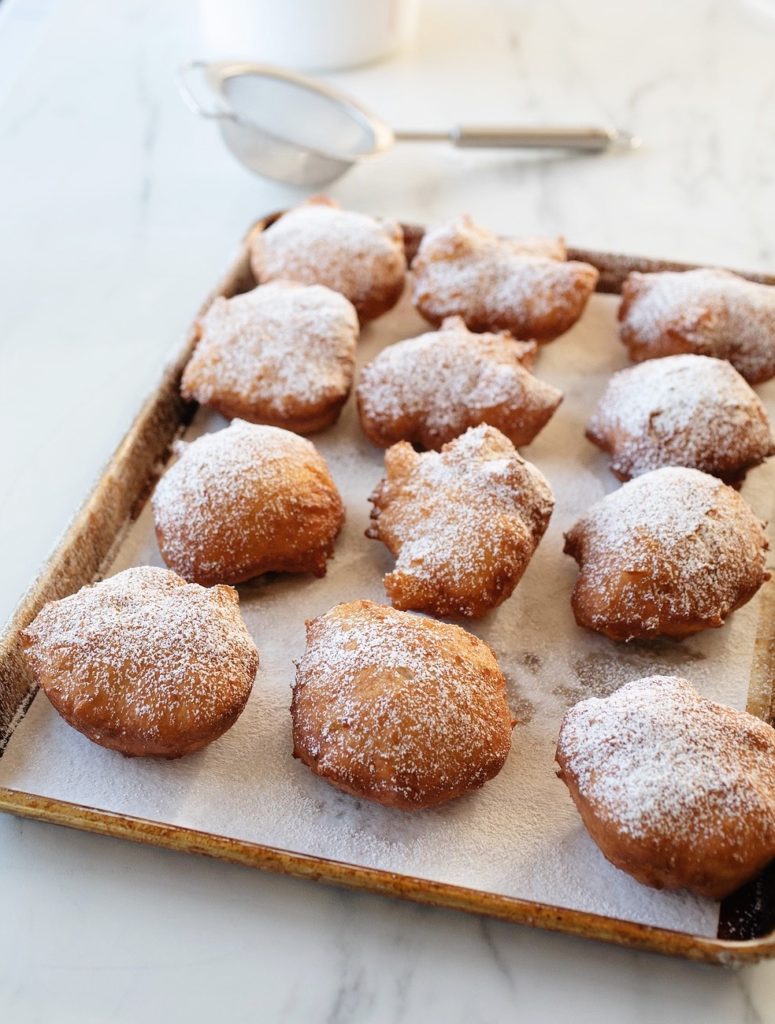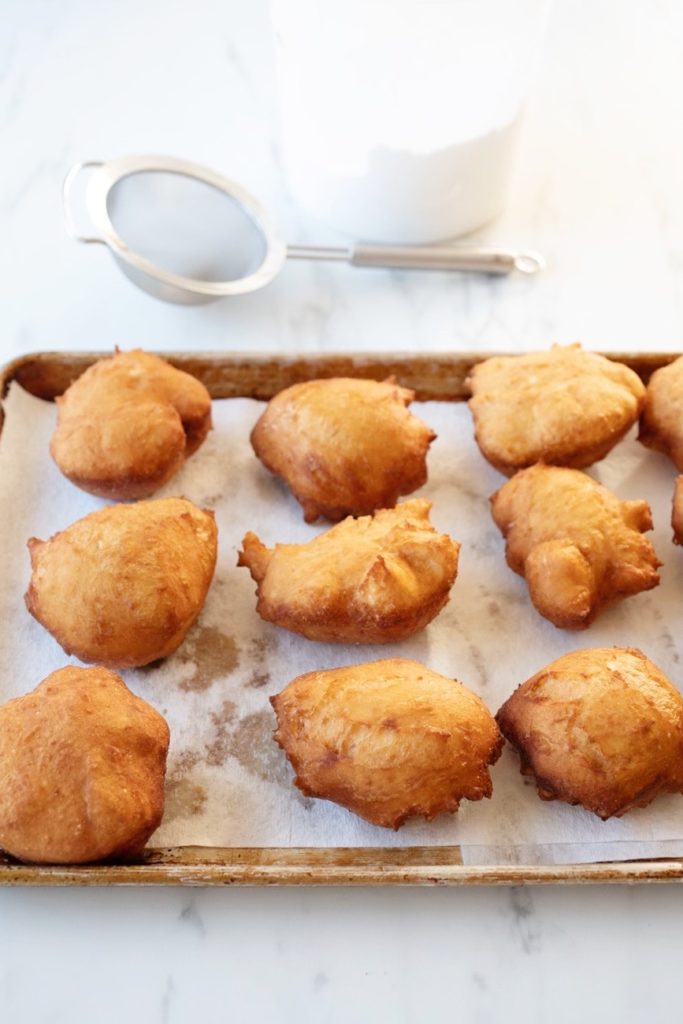
Zeppole (Italian Christmas doughnuts): with Instagram-Live video

Zeppole are a traditional Italian doughnut–a Christmas treat, but the internet holds many different descriptions and definitions of what they are. Some versions are carefully piped, some are made as small doughnut holes, and some are roughly free-form. Years ago I ate the latter rendition in New York at the San Gennaro Street Festival in Little Italy, (which is held in September, so these aren’t just for Christmas) and he loved them so much he knew we needed a post about them.
The version here is based on the Beignet recipe from my book New Artisan Bread in Five Minutes a Day; the dough is no-knead, of course, and is lightly flavored with orange and lemon. I must admit I was a little nervous not pulling out my doughnut cutter to make perfect circles, but we need to embrace the irregular shape: let go and toss the roughly-shaped dough in to the very hot oil.
The golden brown Zeppole that emerged a few minutes later were absolutely delicious; their haphazard shapes gave them a charming quality, and the gentle citrus flavors were lovely. I’m not Italian, but these really are too good not to anyone’s Holiday tradition. And if you’ve been to the blog before at this time of year, you’ll remember these zeppole are very, very similar to Hannukah soufganiot (see the soufganiot post for more on frying up doughnuts).
On Instagram.com/breadin5, you can watch an Instagram reel and see the zeppole-frying!

Zeppole
This recipe is based on the beignet recipe from our book, New Artisan Bread in Five Minutes a Day, page 316.
2 3/4 cup lukewarm water
1/4 cup orange juice
1 tablespoon granulated yeast
1/4 cup granulated sugar
1 tablespoon lemon zest (you will need a microplane zester)
1 tablespoon Morton Kosher Salt
6 1/2 cups all-purpose flour
Vegetable Oil – 3 to 4 inches deep (use a pot that is large enough that your oil is not sitting too high in the pot)
Confectioners’ sugar for sprinkling
Combine the warm water, orange juice yeast, sugar, lemon zest, and salt in a 5-quart bowl; preferably, in a lidded (not airtight) plastic container or food-grade bucket. Mix until all of the flour is incorporated using a stand mixer or dough whisk. Cover, and allow to rise at room temperature for 2 hours. You can use the dough right away, or refrigerate it for up to 14 days.
On Baking Day (if you need to see a visual, you can check out our other post on doughnuts here, with more pictures on shaping and frying).
Line a baking sheet with parchment paper, and lightly grease the parchment.
Pull out 3 oz pieces of dough (peach-sized) piece of dough, and flatten them slightly (the whole bucket of dough will make 15 to 20 zeppole, but you can do fewer pieces if desired). Place them on the prepared pan and cover with a lightly greased piece of plastic. Allow the dough to sit for at least 20 minutes (and up to one hour) while the oil heats up.
Once your oil reads 360-370°F on a Candy Thermometer you are ready to fry. Use a slotted spoon or Basket Strainer to flip the doughnuts over after about 2 minutes and then to take them out of the oil once they are golden brown on both sides. This works best with two people – have one person shape the dough, and the other to manage the submerging and turning. Try to keep the oil temperature as consistent as possible. Lay them out on paper towel to allow some of the oil to drain off. Let the zeppole sit for a few minutes, then lightly dust with confectioners’ sugar. Serve warm.

Note: BreadIn5.com is reader supported–when you buy through links on the site, BreadIn5 LLC earns commissions.
This looks wonderful. Will it work Gluten-Free?
It should, because we succeeded with doughnuts in Gluten-Free Bread in Five Minutes a Day, which is available here: https://artisanbreadinfive.com/gf
Can this recipe be cut in half?
Hi Karen,
All of our recipes can be cut in half. Easiest done when using weights.
Thanks, Zoë
Do you have this class o n Craftsy? also the soufganiot (see the soufganiot post for more on frying up doughnuts).
What is Akismet ???? Thank you for sharing and how do I get to your
We have a more general class on Craftsy: https://www.craftsy.com/class/artisan-bread-in-minutes/
Akismet is just a technology thing that filters out spam. Looks like you didn’t finish your last sentence!
I have adapted Puerto Rican Mallorca using the 5 Minute a day methods. This is a semi sweet “snail” rolled treat, dusted with powdered sugar. My seven year old grand daughter makes several dozen of them for our annual Puerto Rican-Swedish neighborhood New Years Eve party. This is a now five year tradition inspired when we moved into our incredible neighborhood and built a “friendship gate” between our backyard connecting to our friends yard. They haven’t had these sweet rolls since moving from Puerto Rico ten years ago. When we have our party, they roast a whole pig in their China Box roaster, and we all make sides and appetizers and these Mallorca. Our neighbors PR friends gobble them down. The adults party at their house and we set up our house for kids. We make traditional Swedish Christmas Tomtes and the kids decorate Christmas cookies, play games, watch movies and wait for fireworks. Its a glorious start to a new year. I would love to share our adapted recipe if you are interested. We have also adapted a Czech Vanoka bread and Chocolate Babka.
Wonderful story, thanks for sharing! We already have a Mallorca roll recipe of our own, based on our approach to high-moisture dough. It’s at https://artisanbreadinfive.com/2013/04/30/soft-puerto-rican-sweet-buns-mallorca-with-gold-medal-flour/. And Babka in our books, plus a few Czech sweet things…
This brought back so many delicious memories. I just had to go look up my recipe for Zepoli. My Grandma, born in Italy made them every year and I have her recipe. it is not like yours, no juice or zest and milk instead of the water.
I’m going to make them both, hopefully by the holidays and compare. I bet both will be delicious.
Joan
Thanks Joan, please let us know what you find. This of course will work with any dough as you may know from our books, where we use an egg enriched dough for a similar donut
My grandmother used to make Zeppole savory, with no sweetness, but had black pepper in them. I think she fried them in olive oil too. They were very good.
Funny you should bring that up. Most recipe books say that olive oil has too low of a smoke point for this kind of deep frying. But years ago, a guy from (basically) the olive oil council of California or something like that, told me that if you use extra virgin olive oil, the smoke point is high enough that you can use it this way. Definitely an expensive option, but I bet it’s delicious. And of course this will work with savory.
This is not about the doughnuts, but it seems to be how to get any question answered, if I have read the information correctly. I’ve been using the first three books for years – baked almost everything in the first one to try, and totally love everything! I’ve never had a failure, but today I have a problem. Master recipe dough, Artisan Bread in Five Minutes a Day, 1st. edition, p. 26. My dough is so sticky and glutinous, day after making and storing, that I can’t even cut a chunk out properly, and then when I’ve “ripped” it out of the container, cannot do a gluten cloak, as it stick to everything. More flour, into the dough? I’d appreciate an answer, if you have one, so that my container of dough isn’t wasted. In today’s world of scarce flour and yeast, I want to use every scrap. Thank you.
Hi Shelagh,
It sounds like there just isn’t enough flour in this batch, so you can add more flour until it resembles the dough you are used to working with from our method. Once you add the flour, let the dough rest for at least an hour, so the flour can absorb the excess water. Then you can form your loaf.
Thanks, Zoë
These doughnuts are fabulous. Tastes just like they came from Little Italy.
So glad you enjoyed. Come back anytime you have questions about the recipes